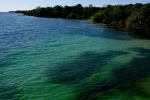Corales del Rosario and San Bernardo National Marine Natural Park. Cartagena de Indias - COLOMBIA
Direccion:
45 km al suroeste de Cartagena Web:
www.parquesnacionales.gov.co/ The Corales del Rosario and San Bernardo National Marine National Park is a protected area and is located on the Caribbean coast of Colombia, comprises a large marine area off the coast of the departments of Bolivar and Sucre, occupying an area of approximately 120,000 hectares .
The National Park constitutes a valuable underwater set of ecosystems of the highest productivity and biodiversity, which form the most extensive coral platform of the Colombian continental Caribbean, is inhabited mainly by corals that house hundreds of microscopic animals, fish of different shapes and colors, Crustaceans, molluscs, anemones, sea urchins and starfish and a wide range of sea birds including the pelican, the wolf bird, among others.
Flora and Fauna in the National Park
In the case of coral reefs, 62 species of corals and other celenterates have been identified, among which are the maple horn coral (Millepora complanata,) the lettuce coral (Agaricia teniufolia) and the siderastrea coral sidereal. Likewise, 18 species of soft corals have been identified, among which are the sea fan (Gorgonia ventalina), among other species.
As for the terrestrial vegetation, we find a remnant of tropical dry forest in the Rosario Island sector in the Archipelago of Our Lady of the Rosary. This forest is characterized by having some type of deciduous vegetation, where plants lose their leaves in summer to save energy and counteract the lack of water.
How to get there
Terrestrial Route: you can access the beach called Playa Blanca, which is reached from the city of Cartagena de Indias, crossing the Campo Elias Teran Dix bridge, located near the Pasacaballos district, 20 minutes from the island complex of the Archipelago of Our Lady of the Rosary.
Maritime Route: From the city of Cartagena de Indias, you must access the Protected Area from the La Bodeguita tourist pier, located on Avenida Blas de Lezo, in front of the De La Marina Park, there are the operators authorized to provide tourist services and from where to sail the boats towards the Archipelago of Our Lady of the Rosary, the tour lasts from 1 to 2 hours approximately everything depends on the type of boat and the places to travel.
From the Municipality of Santiago de Tol? in the department of Sucre, you must access the Protected Area from the Tol? dock or jetty, located on the street next to the sea, there are the operators authorized to provide tourist services and from where they depart Boats to the islands of the San Bernardo Archipelago, the journey lasts approximately 1 hour, depending on the type of boat and the place to visit.








